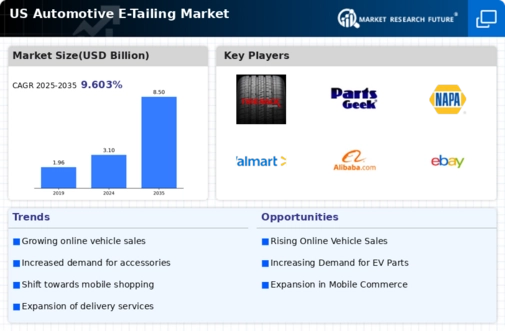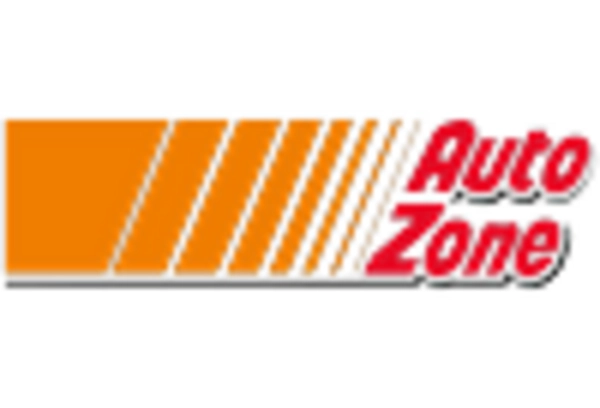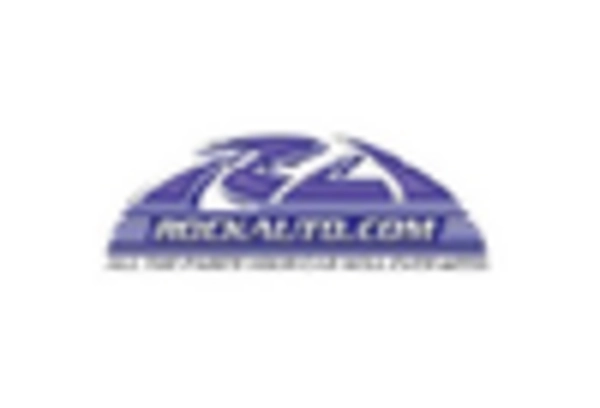Expansion of Product Offerings
The automotive e-tailing market is seeing an expansion of product offerings, a crucial driver of growth. Retailers are increasingly diversifying their inventories to include a wide range of automotive parts, accessories, and services. This diversification not only attracts a broader customer base but also encourages repeat purchases. For example, the introduction of subscription services for automotive maintenance products has gained traction, appealing to consumers seeking convenience. As of 2025, it is projected that the variety of products available online will increase by 25%, further enhancing the attractiveness of the automotive e-tailing market. This expansion is indicative of retailers' efforts to meet diverse consumer needs.
Influence of Social Media Marketing
The automotive e-tailing market is influenced by social media marketing strategies. Platforms such as Instagram and Facebook are increasingly utilized by retailers to engage with potential customers and promote their products. The visual nature of these platforms allows for effective showcasing of automotive products, which can lead to higher conversion rates. Recent data indicates that approximately 40% of consumers discover new automotive products through social media channels. This trend suggests that a robust social media presence is essential for businesses aiming to thrive in the competitive automotive e-tailing market. As engagement on these platforms continues to grow, so too does the potential for increased sales.
Rising Demand for Aftermarket Products
The automotive e-tailing market is seeing rising demand for aftermarket products, driving growth in this sector. Consumers are increasingly seeking customization options and enhancements for their vehicles, leading to a surge in the online purchase of aftermarket parts and accessories. This trend is supported by the fact that nearly 50% of vehicle owners express interest in personalizing their vehicles, with many opting to purchase these products online. The convenience of e-tailing allows consumers to easily compare prices and find the best deals, further fueling this demand. As the trend towards vehicle personalization continues, the automotive e-tailing market is likely to expand, catering to the evolving preferences of consumers.
Technological Advancements in E-commerce
The automotive e-tailing market is seeing a surge due to rapid technological advancements in e-commerce platforms. Enhanced user interfaces, improved payment gateways, and augmented reality features are transforming the online shopping experience. For instance, the integration of AI-driven chatbots is facilitating real-time customer support, thereby increasing consumer confidence in online purchases. Furthermore, the adoption of mobile applications has streamlined the purchasing process, making it more accessible. As of 2025, it is estimated that around 60% of automotive e-tailing transactions occur via mobile devices, indicating a shift in consumer behavior. This trend suggests that businesses must continuously innovate to remain competitive in the automotive e-tailing market.
Growing Consumer Preference for Online Shopping
The automotive e-tailing market is benefiting from a shift in consumer preferences towards online shopping. A significant portion of consumers now favors the convenience of browsing and purchasing automotive products from the comfort of their homes. According to recent surveys, approximately 70% of consumers express a preference for online shopping over traditional retail, citing time savings and ease of access as primary reasons. This trend is further fueled by the increasing availability of detailed product information and customer reviews online, which enhance decision-making. As consumers become more accustomed to e-commerce, the automotive e-tailing market is likely to see sustained growth, driven by this evolving consumer behavior.

















Leave a Comment